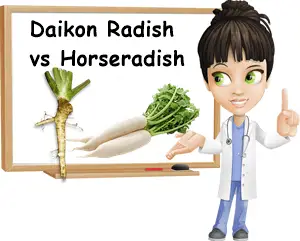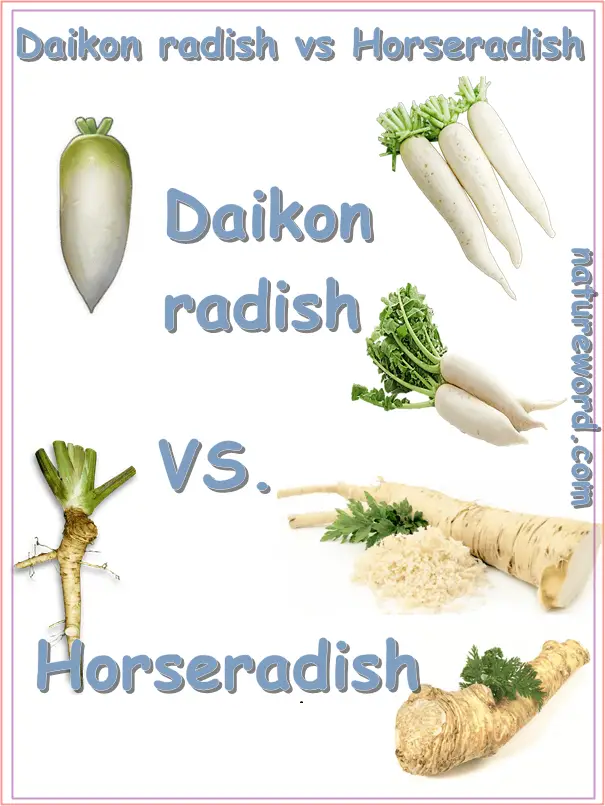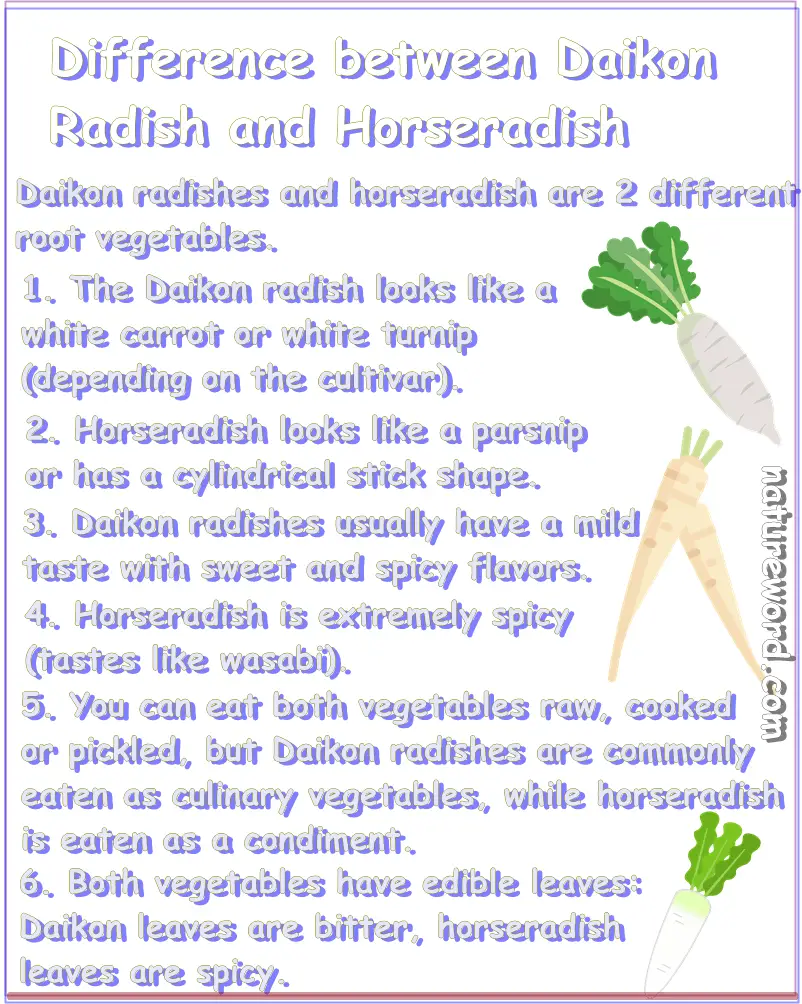Is there a difference between Daikon radishes and horseradish? Is Daikon radish the same thing as horseradish? Or are they different vegetables? What is the difference between Daikon radish vs horseradish? What is a Daikon radish? What is horseradish? What do they look, taste like and do for you in terms of benefits for health?
Is Daikon radish the same as horseradish?
The Daikon radish and horseradish are not the same thing. They are, in fact, two different vegetables, but related to one another. Daikon radish and horseradish both belong to the Brassicaceae family which is the cabbage family or mustard family. But each belongs to a different genus: the Daikon radish belongs to the Raphanus genus, that is, radishes, while horseradish belongs to the Armoracia genus.

What is Daikon radish?
The Daikon radish is a type of root vegetable that grows underground. The Daikon radish is, as its name indicates, a variety of radish. It’s related to white winter radishes such as the Korean radish, and to black radishes such as the Spanish black radish. It’s also related to common pink radishes or red radishes, and purple or plum radishes.
The Daikon radish is called a seasonal winter radish because it was originally grown over winter, although it’s now available year round. Aside from being a culinary vegetable, it is also used as animal feed and as a fallow crop to combat soil compaction and improve soil structure and nutrients availability.
What is horseradish?
Horseradish is a different type of root vegetable altogether, but related to the Daikon radish. Although a root vegetable, its primary culinary use that of condiment and spice. Vs horseradish, the Daikon radish is eaten as a culinary vegetable. Because freshly prepared horseradish is extremely pungent in taste, consumption is often limited to very small amounts.
Daikon radish vs horseradish: appearance
If you’re not familiar with either Daikon radishes or horseradish, then you might be happy to know that you stand a pretty good chance of telling them apart by how they look. Albeit, there is quite a lot of variation in size and shape in both vegetables.

What do Daikon radishes look like?
Daikon radishes have a relatively smooth skin and are grown in such a way that they are almost completely white, or white with green tops. Daikon radishes are called winter radishes both because they are commonly cultivated over winter, and because they are white as winter snow. Both the skin and the flesh are white. Daikon radishes range in size and shape depending on the cultivar, but are usually more uniform looking, resembling either carrots or turnips in shape.
The most popular type of Daikon radish is the Japanese Daikon radish which is a cultivar with a long, white, tapering root that looks very much like a long white carrot. The Sakurajima Daikon is a cultivar of the Japanese Daikon, essentially a turnip-shaped giant Daikon radish that typically grows to 5-10 kilograms, but is known to reach up to 30 kilograms. Chinese varieties are often somewhat shorter and stouter. There is also an heirloom Chinese Daikon radish variety with light green skin and watermelon-pink flesh called the ‘watermelon radish’ or ‘Chinese daikon’.
What does horseradish look like?
Horseradish looks more like a root compared to the Daikon radish. Horseradish is either carrot-shaped, that is, long and tapering like a carrot or parsnip, or just long and thin like a stick. The skin is cream colored which makes it look a lot like parsnip. The flesh however is crisp white. Horseradish can be knobby like celery root (celeriac).
Daikon radish vs horseradish: taste
What does Daikon radish taste like? The Daikon radish is mildly pungent to sweet in taste with a crisp white flesh. However, growing conditions affect taste quite a lot. For example, drought makes Daikon radishes taste spicier, more pungent, while radishes from a winter harvest are sweeter and less pungent. Also, younger roots are more tender and mild tasting, while older roots are tougher, sometimes woody even, and more pungent.
What does horseradish taste like? Horseradish is like a sort of Western wasabi, that is, it tastes pungent and spicy, similar to wasabi. But there’s a catch. It only tastes spicy when freshly grated, minced or crushed. Exposure to air causes the pungency to fade completely in a matter of hours to days. As a result of exposure to air, the flesh also oxidizes becoming darker and bitter instead of spicy. Even when properly stored (e.g. in a sealed jar, marinated in vinegar like pickles and stored in a dark, cool place), horseradish stays pungent for only about 2 months after which the pungency starts to fade.

Daikon radish or horseradish?
How do you tell apart Daikon radishes from horseradish? By the way they look and taste. Daikon radish has a smooth, white skin with sometimes green tops. By comparison, horseradish has a rough, cream colored skin, and can even be somewhat knobby. Most varieties of Daikon radish look like white carrots, or white turnips, vs horseradish which looks more like parsnip. Daikon radishes typically have a mild pungent taste with light sweet flavors, similar to how radishes in general taste, while horseradish tastes spicy and pungent when fresh.
In terms of uses, Daikon radishes are consumed primarily as a culinary vegetable, while horseradish is consumed as a spice or condiment and rarely as a culinary vegetable. Horseradish is actually used as a substitute for wasabi. In fact, the practice is so common that horseradish is commonly called ‘Western wasabi’. Daikon radishes are also commonly pickled, either alone or with carrot or beetroot, and so is horseradish. You can however eat horseradish boiled in soups.
More facts about Daikon radish vs horseradish
- You can eat both Daikon radishes and horseradish raw, but horseradish is very spicy.
- You can pickle both Daikon radishes and horseradish, either alone or in combination with different carrot colors, beetroot, onion, garlic, chili peppers, turmeric, persimmon peels, with a brine made from salt, sugar, honey, vinegar or sake.
- Fresh and pickled horseradish and spicy pickled Daikon are best consumed in small amounts and infrequently, especially if you have an active gastritis, acid reflux disease or a peptic ulcer.
- Daikon radishes and horseradish are commonly eaten raw or pickled, as a side dish, garnish or topping.
- Both Daikon radish and horseradish leaves are edible. You can eat the young and tender leaves, and microgreens raw, and the older, bitter or pungent leaves cooked.
- Daikon radishes have half the calories of horseradish, but both root vegetables are very low in calories.
- The serving size for Daikon radish: the same as for other culinary vegetables (e.g. 100 grams, 150 grams, 1 cup, 1 medium sized radish). The serving size for horseradish: the same as for other condiments, that is, no more than 15-20 grams at once.
- Both Daikon radishes and horseradish have a modest nutritional value. But when consumed in normal food amounts, Daikon radish provides modest nutrition, whereas horseradish barely contributes to daily nutritional requirements due to the small serving size it is meant to be consumed in.
- Both Daikon radishes and horseradish have anti-inflammatory effects, anticancer properties, antiviral and antibacterial action, and are a source of antioxidants and other biologically active components with benefits for health.
